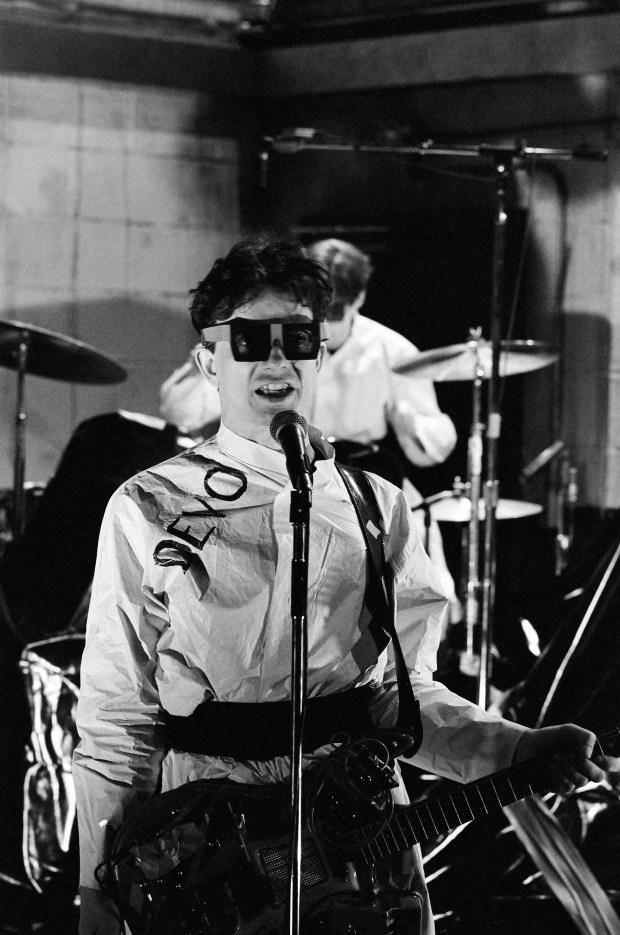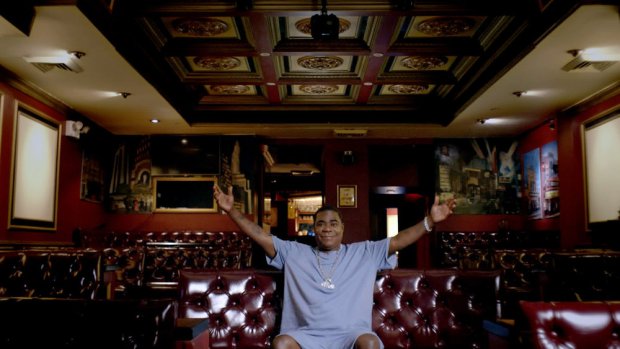If it felt like “Saturday Night Live” took to the airwaves in 1975 with a renegade spirit, 50 years later it’s become not only a late-night tradition, but traditional. Hitting the half-century mark is a milestone. But a show doesn’t stick around that long because it’s willing to experiment or step on toes, but because it is fully embraced by the establishment.
That’s the likely unintended subtext throughout the various behind-the-scenes documentaries produced by NBC ahead of the show’s 50th anniversary special airing Sunday. These are in-house projects that stay on-message — warm and laudatory — but they are not without their fascinating moments. All can be streamed on Peacock.
An additional programming note: The first episode of “Saturday Night Live,” which originally aired on Oct. 11, 1975, with host George Carlin and musical guests Billy Preston and Janis Ian, will air on NBC in “SNL’s” usual late-night timeslot this weekend, in place of a new episode.
“Ladies & Gentlemen… 50 Years of SNL Music”
Co-directed by Oz Rodriguez and Ahmir Thompson (aka Questlove), the two-hour documentary includes a remarkable 7-minute montage of “SNL’s” musical performances that opens the film. But it also puts a long-overdue focus on the show’s musical history, which tends to get sidelined, and it’s a good reminder of the sheer variety of music that has been featured over the years.
- The opening montage blends clips in a way that segues brilliantly from one to the next, as if the songs were sonic cousins that should have been considered in tandem all along. It’s the kind of creative musical gambit we rarely see on TV, put together people who clearly love all genres of music and see how they’re interrelated.
- The show’s opening theme song is instantly recognizable — and in no way hummable. And yet it works. Here’s how Jack White describes it: There is no consistent melody, “it’s just a wailing saxophone of someone being taken out of the building playing saxophone, by the police, and the microphone’s still connected.”
- As someone points out, the similarities between music and comedy are many: Timing, cadence and misdirection. Not mentioned: The prolific use of drugs, especially in the ’70s. But this is a cleaned-up version of “SNL’s” past, so …
- In the show’s first two decades, it was more likely to expose lesser-known bands to a wider audience. Devo in 1978. Talking Heads in 1979. The B-52s in 1980. Funky Four Plus One in 1981 (the first hip hop group to perform on the show, thanks to host Debbie Harry using her clout to get them on). An appearance on national TV used to have a big effect. I wonder if that’s still true, but with fewer places for singers and musicians to perform on live TV, the show still holds relevance in that regard.
- As “SNL” increasingly became mainstream, the documentary is a reminder that the musical acts retained an unpredictable and rebellious edge for a bit longer.
“SNL50: Beyond Saturday Night Live”
The four-part docuseries is hit-and-miss, but maybe that’s fitting since the unevenness mirrors the show itself. This should feel more momentous, especially in the streaming era when a long run might be seven seasons. (According to a recent report in Vulture, “SNL” remains “consistently profitable despite being incredibly expensive to produce” at $4 million an episode.)
Episode 1: “Five Minutes”: The show’s audition process is infamous by this point. Each person steps on an empty stage and performs for a small group of stone-faced decision-makers. The awkward silence is true in some cases, but other times you can hear off-camera guffaws.
- Cast members (mostly from the past 20 years) reminisce about the experience as they watch footage of their auditions. Some are cringe, but a handful are surprisingly good, including Will Ferrell, who was fully-formed from the start. There are the people who didn’t make the cut but went on to significant careers anyway: Jim Carrey, Jennifer Coolidge, Mindy Kaling, Kevin Hart, Stephen Colbert. The Dick Ebersol years — when executive producer Lorne Michaels left the show from 1981 to 1984 — might as well not exist, and there are only brief snippets of the original Not Ready for Primetime Players, including Dan Aykroyd and Jane Curtain. It’s such a weirdly recent assemblage who are featured. The ’70s, ’80s and most of the ’90s are elided, even though the whole point is that the show has been around for 50 years
- Of the show’s casting and talent staff interviewed, you notice the dearth of Black people and other people of color and it makes you wonder in what ways — subconscious or otherwise — that’s affected the show’s lineup over the years.
- Ego Nwodim, who joined the cast in 2018, offers some insight into that, albeit indirectly: “I felt like I could do the job in a way that would make it easier for the next Black woman. And I say this not to say that every day I’d go in thinking, ‘This is for Black women!’ — I wasn’t. But I wanted the audience to have a point of reference of a Black woman they felt had the skill set to do the job and their brains could go, ‘Oh yeah, she belongs.’ And then the next Black woman who comes after me, my hope is her time is 5% easier because of the work I did there.” She says she benefits from the Black women who came before her. There were just five. In 50 years.
- In case you were wondering if nepotism is part of the “SNL” fabric, of course it is! We learn that George Wendt called “SNL” about considering his nephew Jason Sudeikis.
Episode 2: “More Cowbell”: The weakest of the episodes, it functions as an anatomy of a sketch. Specifically the “More Cowbell” sketch (technically called “Recording Session”) from 2000 starring Christopher Walken and envisioned by Will Ferrell as an absurdist version of Blue Öyster Cult recording the band’s 1976 hit “(Don’t Fear) The Reaper.” The sketch is fine. Funny even! I’m not sure it’s interesting enough to warrant a one-hour, semi-tongue-in-cheek episode about the making of it. Surely there were other sketches with better backstories.
Episode 3: “Written By: A Week Inside the ‘SNL’ Writers Room”: This would be compelling if James Franco hadn’t already made a documentary called “Saturday Night” documenting the same process. It’s embarrassing how alike the two projects are. For a more comprehensive, warts-and-all look at the show, you can check out the nonfiction book “Live from New York: An Uncensored Story of Saturday Night Live as Told by Its Stars, Writers, and Guests.”
There’s also a new biography about 80-year-old Michaels by Susan Morrison called “Lorne: The Man Who Invented ‘Saturday Night Live’” that broaches topics these documentaries studiously avoid, including staff pushback Michaels received when he booked Donald Trump to host during his campaign for president in 2015: Despite Michaels’ insistence that the show was non-partisan, the writers felt he was putting his thumb on the scale and “‘helping’ Trump — a sentiment that was only bolstered amongst staff who recalled to Morrison that Michaels had wanted to ‘tone down a harsh Trump sketch’ and allow him to show ‘some charm.’”
- The writers are droll about their second-tier status. “I believe our names roll by extremely fast over shots of the castmates hugging and meeting the famous people,” says head writer Streeter Seidell. A lot of famous people were writers on the show — but only became famous once they left the show and found opportunities on camera, including Will Arnett, Larry David, John Mulaney, Sarah Silverman.

- The writers produce their own sketches, meaning they write the scripts but are also responsible for helping to shape the performances and working with the rest of the crew on the sets and costumes. Louie Zakarian, head of the makeup department, has been building prosthetics on the show for nearly 30 years. “We did a ‘Game of Thrones’ sketch and we had one night to build a dragon,” he says. I would have loved an episode focusing on how these art departments actually function on such a short timeframe, creating everything from scratch each week.
- “You are fully in charge of three to four minutes of live network television,” says Mulaney about the autonomy writers are given. “NBC had nothing to say about it. Nothing. And when they did, we’d tell them no. We’re like 25 and we’d go, ‘We’re doing it.’” It’s a weird framing considering the show isn’t in the business of controversy or boundary pushing.
- Writer Celeste Yim’s path to the show: “I went to NYU for playwriting and was like, ‘Great, this is it, I’m going to be a playwright and write about things that really matter.’ And then basically immediately got the most corporate comedy job in the world.” This is the first time someone actually names it instead of buying into the lore — “SNL” may be desperate to style itself as bold, but at the end of the day, it’s just corporate.
- More than anything, you feel a deep sympathy for the writers. They seem beaten down and miserable, in it for the rare adrenaline rush of a sketch getting big laughs, but also mostly because it’s the kind of resume item that can lead to other jobs down the line. There’s nothing easy about comedy and the pressure to write funny material on a short deadline is daunting. I think it’s OK that a lot of it doesn’t work. But you wonder if the environment fostered by Michaels is the only way to do it. (As the aforementioned Vulture piece points out: “His age has added an undercurrent of queasiness to the 50th anniversary victory lap as Michaels’s empire rolls on without a firm succession plan. For better or worse, the machinery of American comedy has built up around him, and no one knows how the laugh factory will function if Michaels retires — or what it means if he chooses to cling to the show into his twilight years.”)
Here’s Tina Fey: “The rewrite tables were tough. They were grouchy. People would take the rundown of the show and just go through it, sketch by sketch, and make fun of it. Make fun of the title. Goof on it, goof on it, goof on it. You would leave the room fully knowing that that writers room was taking a (dump) on it while you were gone, and it just was kind of the way it was.”
“I don’t know if it’s the same anymore,” she says (the documentary doesn’t bother providing an answer). “Maybe it should get that way again a little bit,” Fey adds, and it would have been enlightening to hear why she thinks that kind of backbiting is beneficial to creativity. The idea that people can only do their best work under those circumstances probably deserves to be challenged.
Episode 4: “Season 11: The Weird Year”: Finally, Ebersol’s existence is (barely!) acknowledged, if only because Season 11 marked Michaels’ return to “SNL” as executive producer, taking over for Ebersol. Michaels’ eye for talent has always been one of his strengths, but you could say the same of Ebersol, who assembled casts that included Eddie Murphy, Billy Crystal and Martin Short. Well, regardless, Michaels cleared house when he came back, hiring a number of performers — including Randy Quaid, Anthony Michael Hall and Robert Downey Jr. — who had little or no previous sketch comedy experience.
- The episode is the only one that even vaguely criticizes Michaels, but you really have to read between the lines because he’s portrayed as a godlike figure. (Even at this point, he was already living a certain lifestyle; people remember being called out for meetings by the pool at his house in the Hamptons.)
- That Michaels failed to create an environment in which a talent like Damon Wayans could thrive is such a big mark against him (Michaels fired him that season).
- There’s a lot of emphasis that the show faltered during Season 11 (tensions between the writers and the cast is alluded to) but the documentary and its participants don’t analyze more deeply the why of it all. At any rate, the season ended with a sketch that literally envisioned the cast set on fire.
- I had forgotten that Michaels brought Francis Ford Coppola on to direct an episode that season, with Coppola on camera for some of it. It’s such a departure for the show and just the kind of experiment you wish the show had embraced in the years since.
- Jon Lovitz has the best observation about the show, then and now: “We’re live but we’re not taking advantage of it.”
Nina Metz is a Tribune critic.




